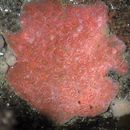Comprehensive Description
provided by Invertebrates of the Salish Sea
Biology/Natural History: In California, colonies of this species can grow to 7 cm diameter in 3 months. The larvae are brooded in the atrial cavity in spring and summer. The symbiotic copepod Arthurhumesia canadensis may be present inside the zooids. The amphipod Polycheria osborni is also a rare symbiont. The nudibranch Hermissenda crassicornis often feeds on the zooids.
- license
- cc-by-nc-sa
- copyright
- Rosario Beach Marine Laboratory
Habitat
provided by Invertebrates of the Salish Sea
Rocks and pilings in areas with current.
- license
- cc-by-nc-sa
- copyright
- Rosario Beach Marine Laboratory
Distribution
provided by Invertebrates of the Salish Sea
Geographical Range: Southern British Columbia to San Diego, CA
- license
- cc-by-nc-sa
- copyright
- Rosario Beach Marine Laboratory
Habitat
provided by Invertebrates of the Salish Sea
Depth Range: Intertidal to 40 m
- license
- cc-by-nc-sa
- copyright
- Rosario Beach Marine Laboratory
Comprehensive Description
provided by Invertebrates of the Salish Sea
This compound, colonial tunicate has many individuals all enclosed within the same gelatinous tunic. The colony grows as a thick, gelatinous or fleshy, encrusting, often lumpy sheet or slab which is at least 5 mm thick but does not have a stalk. The zooids are arranged in systems--individual zooids have their oral apertures separately at the surface, but the atrial apertures of multiple zooids all open together into the same cavity with a single, larger opening. The overall colony color is red, pinkish, or pale and may be encrusted with sand. The separate oral siphons of the zooids are usually red or orange-brown. The pharynx of zooids has 12-16 rows of stigmata. Colonies may be up to 5 cm thick. Colony diameter to 20 cm.
- license
- cc-by-nc-sa
- copyright
- Rosario Beach Marine Laboratory
Look Alikes
provided by Invertebrates of the Salish Sea
How to Distinguish from Similar Species: Aplidium californicum also forms a gelatinous or fleshy colony with zooids in systems but the zooids are tan, yellowish, or orange-brown and usually have less stigmata on the pharynx. Archidistoma molle can be reddish or pink but the zooids are not in systems and the colony tends to be globular in form.
- license
- cc-by-nc-sa
- copyright
- Rosario Beach Marine Laboratory
Aplidium solidum
provided by wikipedia EN
Aplidium solidum is a species of colonial sea squirts, a tunicate in the family Polyclinidae. It is commonly known as the red ascidian or sea pork.
Description
Aplidium solidum is a compound tunicate forming sheets or slabs up to 20 cm across on rocks and other hard substrates. The tunic is gelatinous but firm in consistency, 2 to 3 cm thick and a red or pink colour. The individual zooids are bright red, 12 mm long and arranged in small systems. There are usually 13 to 15 rows of gill-like perforations in the pharynx of each.[2][3]
Distribution
The type location of Aplidium solidum is Pemba Island, Tanzania and it is also found in Australian waters.[1] It occurs on the west coast of North America from British Columbia south to California where it is common on rocks, especially among the holdfasts of kelp forests, and pilings.[2] It occurs in the intertidal zone and at depths down to 40 metres.[3]
Biology
Aplidium solidum is a filter feeder. Water is sucked into the interior of the organism through an oral aperture and then expelled through a larger one, common to all the zooids in the system. Phytoplankton and other small organisms get trapped in mucus threads secreted by the endostyle.[3]
This tunicate breeds in the spring and summer and broods its larvae in its atrial cavity.[3]
The nudibranch, Hermissenda crassicornis, feeds on this tunicate.[2]
References

- license
- cc-by-sa-3.0
- copyright
- Wikipedia authors and editors
Aplidium solidum: Brief Summary
provided by wikipedia EN
Aplidium solidum is a species of colonial sea squirts, a tunicate in the family Polyclinidae. It is commonly known as the red ascidian or sea pork.
- license
- cc-by-sa-3.0
- copyright
- Wikipedia authors and editors
Description
provided by World Register of Marine Species
This species corresponds well to the description given by Knott(1992). The general organization is rather similar to that of Aspledium ritteri (Sluiter,1895) which differs in having small cloacal aperatures and a different conoly shape.
Monniot, F.; Monniot, C. (1997). Ascidians Collected in Tanzania. Journal of East African Natural History. 86(1), 1-35.
- license
- cc-by-4.0
- copyright
- WoRMS Editorial Board
- contributor
- Sigrid Vermaercke [email]

